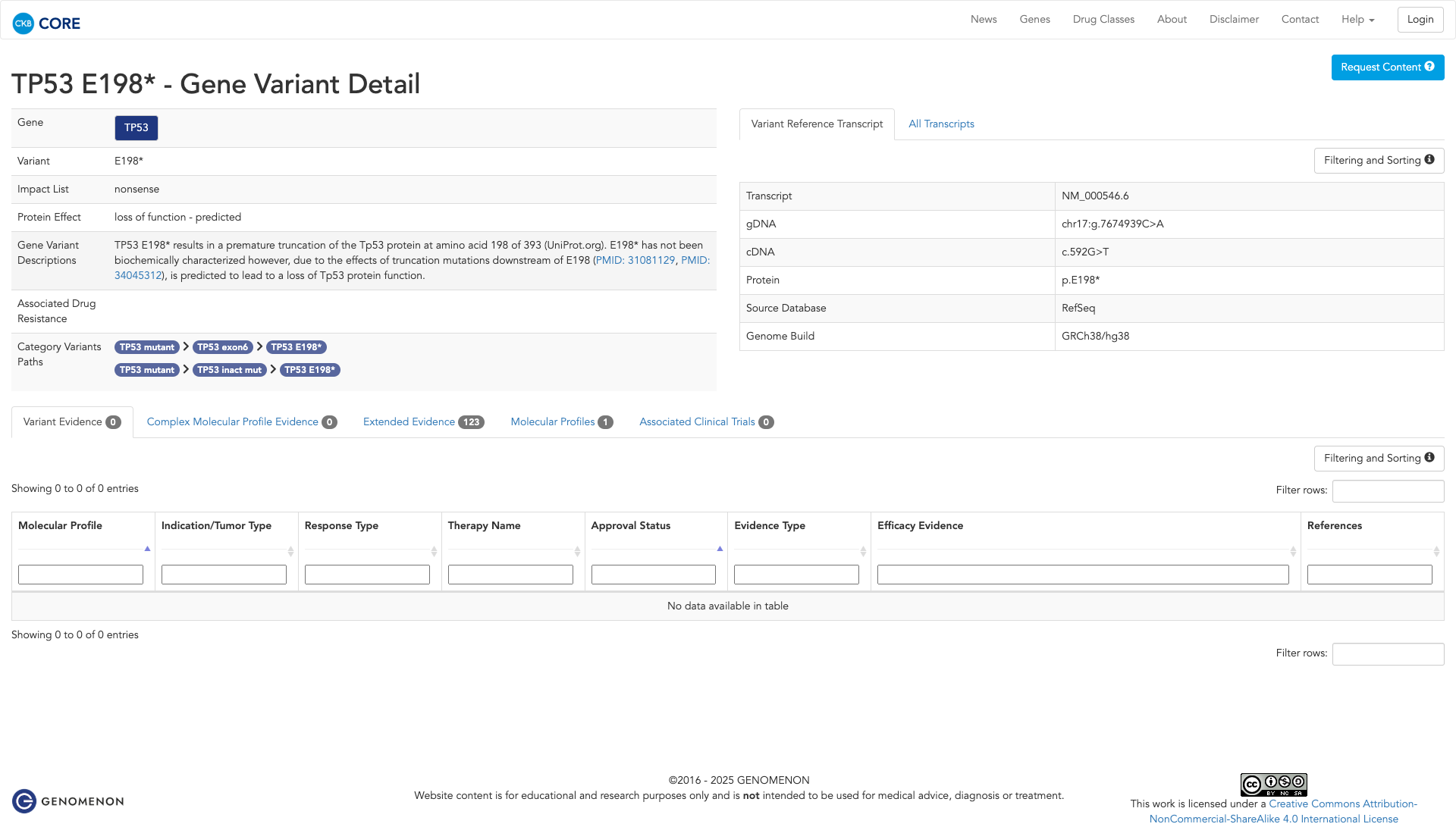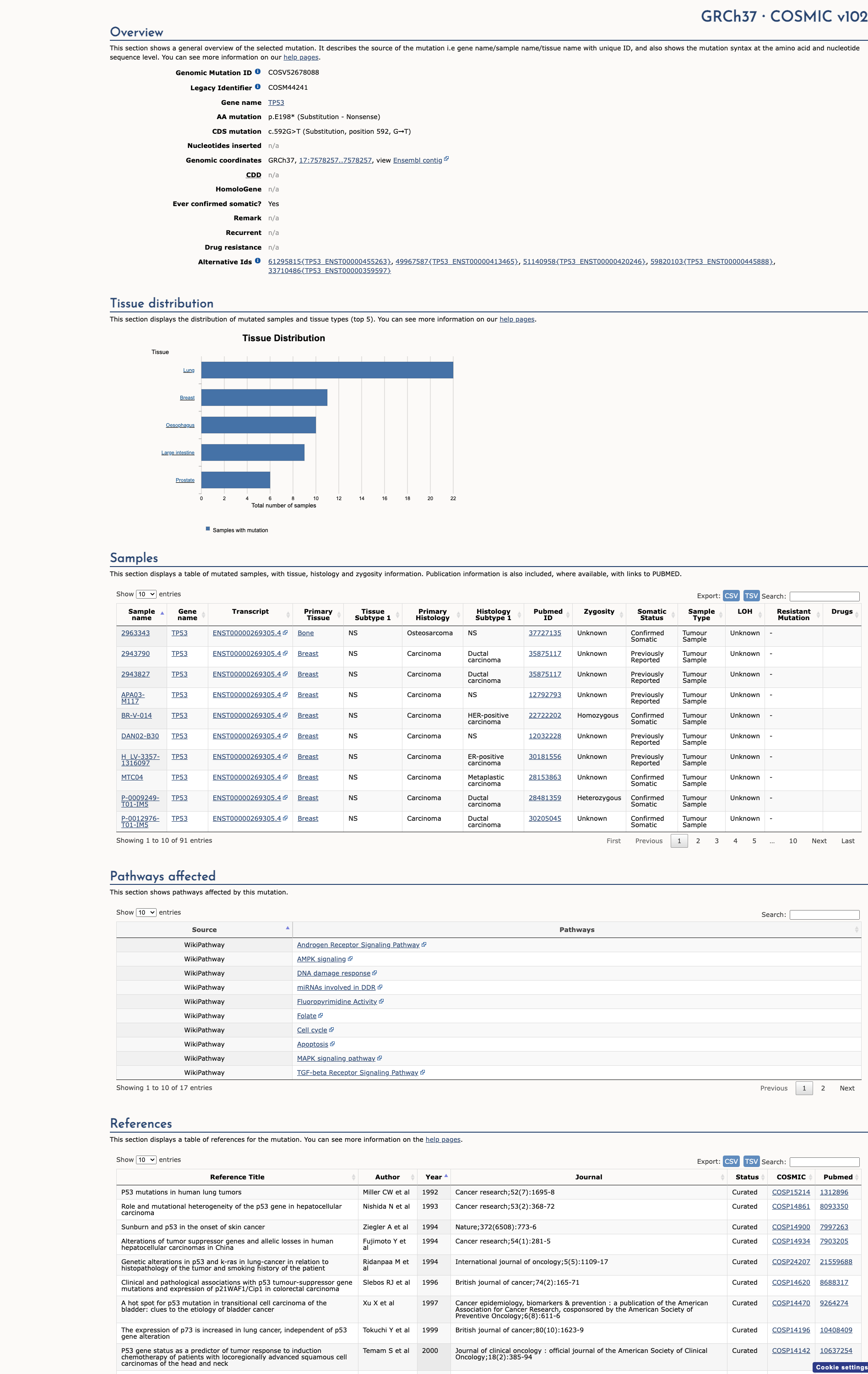TP53 c.592G>T, p.Glu198Ter
NM_000546.6:c.592G>T
COSMIC ID: COSM118011, COSM44241
Pathogenic
The TP53 p.E198* variant is a truncating change predicted to undergo NMD, absent from population databases, and reported as pathogenic in ClinVar. Under TP53 VCEP guidelines, PVS1 (Very Strong), PM2 (Supporting), and PP5 (Supporting) criteria support a Pathogenic classification.
ACMG/AMP Criteria Applied
PVS1
PM2
PP5
Genetic Information
Gene & Transcript Details
Gene
TP53
Transcript
NM_000546.6
MANE Select
Total Exons
11
Strand
Reverse (−)
Reference Sequence
NC_000017.10
Alternative Transcripts
| ID | Status | Details |
|---|---|---|
| NM_000546.5 | RefSeq Select | 11 exons | Reverse |
| NM_000546.3 | Alternative | 11 exons | Reverse |
| NM_000546.4 | Alternative | 11 exons | Reverse |
| NM_000546.2 | Alternative | 11 exons | Reverse |
Variant Details
HGVS Notation
NM_000546.6:c.592G>T
Protein Change
E198*
Location
Exon 6
(Exon 6 of 11)
5'Exon Structure (11 total)3'
Functional Consequence
Loss of Function
Related Variants
Alternate Identifiers
COSM118011, COSM44241
Variant interpretation based on transcript NM_000546.6
Genome Browser
Loading genome browser...
HGVS InputNM_000546:c.592G>T
Active Tracks
ConservationRefSeqClinVargnomAD
Navigation tips: Use mouse to drag and zoom. Click on features for details.
Clinical Data
Population Frequency
Global Frequency
0.0 in 100,000
Extremely Rare
Global: 0.0%
0%
0.05%
0.1%
1%
5%
10%+
ACMG Criteria Applied
PM2
This variant is not present in gnomAD (PM2 criteria applies).
Classification
1 publications
Pathogenic
Based on 1 submitter review in ClinVar
Submitter Breakdown
1 Path
Pathogenic
Likely Path.
VUS
Likely Benign
Benign
Publications (1)
For these reasons, this variant has been classified as Pathogenic. Algorithms developed to predict the effect of sequence changes on RNA splicing suggest that this variant may create or strengthen a splice site. ClinVar contains an entry for this variant (Variation ID: 634704). This premature translational stop signal has been observed in individual(s) with breast or ovarian cancer (PMID: 29625052, 32029870). This variant is not present in population databases (gnomAD no frequency). This sequence change creates a premature translational stop signal (p.Glu198*) in the TP53 gene. It is expected to result in an absent or disrupted protein product. Loss-of-function variants in TP53 are known to be pathogenic (PMID: 20522432).
Clinical Statement
This variant has been reported in ClinVar as Pathogenic (1 clinical laboratories).
COSMIC ID
COSM118011, COSM44241
Recurrence
89 occurrences
PM1 Criteria
Applied
Criterion PM1 is applied based on the high recurrence in COSMIC database.
COSMIC Database Preview
Accessing full COSMIC database details requires institutional login or subscription. External links may prompt for authentication.
Functional Impact
Functional Domain
Hotspot Status
Hotspot
PM1
Mutation Count
26
Reported mutations in this domain
050100+
Domain Summary
This variant is located in a mutational hotspot or critical domain (26 mutations).
PM1 criterion applied.
Related Variants in This Domain
Functional Summary
The TP53 E198* variant is a truncating mutation that results in the production of a C-terminally truncated protein. Functional evidence indicates that such truncating mutations in TP53 are likely to be inactivating, leading to loss of tumor suppressor function. Experimental studies have shown that these mutations can promote cancer cell proliferation, survival, and metastasis, partly due to aberrant protein localization affecting cell survival pathways. Therefore, the TP53 E198* variant is functionally characterized as likely damaging.
Database Previews
OncoKB

JAX-CKB

Click on previews to view full database entries. External databases may require institutional access.
Computational Analysis
Pathogenicity Predictions
Predictor Consensus
Mixed/VUS
PP3 Applied
No
Additional Predictors
Neutral: Show all
VCEP Guidelines
Applied ACMG/AMP Criteria (VCEP Specific) VCEP Guidelines
PVS1
PVS1 (Very Strong)
According to VCEP guidelines, "PVS1 applies to variants predicted to result in nonsense-mediated decay (NMD) for nonsense variants upstream of p.Lys351". The evidence for this variant shows it is a nonsense change (p.E198*) located upstream of p.Lys351 and predicted to undergo NMD. Therefore, this criterion is applied at Very Strong strength because the variant is a null variant in TP53, a gene where loss of function is a known mechanism of disease.
PS1
PS1 (Not Applied) Strength Modified
According to VCEP guidelines, PS1 applies to variants asserting the same amino acid change as a known pathogenic variant via a different nucleotide change. The evidence for this variant shows it is a nonsense variant without any existing missense equivalent. Therefore, this criterion is not applied because the variant does not match a known pathogenic variant at the same residue.
PS2
PS2 (Not Applied) Strength Modified
According to VCEP guidelines, PS2 applies to confirmed de novo variants with appropriate parental testing. The evidence for this variant shows no de novo data are available. Therefore, this criterion is not applied because de novo status has not been established.
PS3
PS3 (Not Applied) Strength Modified
According to VCEP guidelines, "PS3 should not be applied at any strength if PVS1 is applied at full strength". The evidence for this variant shows functional data consistent with loss of function, but PVS1 is already applied at full strength. Therefore, this criterion is not applied to avoid redundancy with PVS1.
PS4
PS4 (Not Applied) Strength Modified
According to VCEP guidelines, PS4 applies based on proband counts and case–control data following the TP53 point system. The evidence for this variant shows no published proband count or case–control data. Therefore, this criterion is not applied because there is insufficient case data to meet any PS4 strength.
PM1
PM1 (Not Applied) Strength Modified
According to VCEP guidelines, PM1 applies to missense variants within specified hotspot codons (e.g., 175, 245, 248, 249, 273, 282). The evidence for this variant shows it is a nonsense variant outside of these missense hotspots. Therefore, this criterion is not applied because PM1 is specific to missense hotspot variants.
PM2
PM2 (Supporting) Strength Modified
According to VCEP guidelines, "PM2 Supporting: Variant should have an allele frequency of less than 0.00003 (0.003%) in gnomAD or another large sequenced population." The evidence for this variant shows it is absent from gnomAD (MAF = 0%). Therefore, this criterion is applied at Supporting strength because the variant is not present in population databases.
PM3
PM3 (Not Applied) Strength Modified
According to standard ACMG guidelines, PM3 applies to recessive inheritance with detected trans occurrences. The evidence for this variant shows no data regarding zygosity or trans observations. Therefore, this criterion is not applied because PM3 is not relevant for a dominantly acting TP53 variant.
PM4
PM4 (Not Applied) Strength Modified
According to standard ACMG guidelines, PM4 applies to protein length changes as a result of in-frame indels or stop-loss variants. The evidence for this variant shows it is a nonsense change leading to NMD rather than an in-frame alteration. Therefore, this criterion is not applied because PM4 does not cover truncating variants predicted to undergo NMD.
PM5
PM5 (Not Applied) Strength Modified
According to VCEP guidelines, PM5 applies to novel missense changes at residues with known pathogenic missense variants. The evidence for this variant shows it is a nonsense change, not a missense variant. Therefore, this criterion is not applied because PM5 is specific to missense variants.
PM6
PM6 (Not Applied) Strength Modified
According to VCEP guidelines, PM6 applies to assumed de novo variants without confirmation. The evidence for this variant shows no de novo or parental data. Therefore, this criterion is not applied due to lack of de novo evidence.
PP1
PP1 (Not Applied) Strength Modified
According to VCEP guidelines, PP1 applies based on cosegregation data points. The evidence for this variant shows no family segregation information. Therefore, this criterion is not applied because segregation data are not available.
PP2
PP2 (Not Applied) Strength Modified
According to standard ACMG guidelines, PP2 applies to missense variants in genes where such variants are a common mechanism and few benign missense variants exist. The evidence for this variant shows it is a truncating variant. Therefore, this criterion is not applied because PP2 is specific to missense variants.
PP3
PP3 (Not Applied) Strength Modified
According to VCEP guidelines, PP3 should not be used in combination with PVS1 at full strength. The evidence for this variant includes mixed in silico predictions, and PVS1 is already applied. Therefore, this criterion is not applied to avoid overlap with PVS1.
PP4
PP4 (Not Applied) Strength Modified
According to standard ACMG guidelines, PP4 applies to variants with highly specific phenotype data. The evidence for this variant shows no individual phenotype or tumor profiling data. Therefore, this criterion is not applied due to lack of phenotype specificity.
PP5
PP5 (Supporting)
According to standard ACMG guidelines, "PP5: Reputable source recently reports variant as pathogenic, but the evidence is not available to the laboratory to perform an independent evaluation." The evidence for this variant shows ClinVar lists it as Pathogenic by one clinical laboratory. Therefore, this criterion is applied at Supporting strength because a reputable database reports it as pathogenic without available primary evidence.
BA1
BA1 (Not Applied) Strength Modified
According to standard ACMG guidelines, BA1 applies to variants with a filtering allele frequency ≥0.001 in gnomAD. The evidence for this variant shows MAF = 0%. Therefore, this criterion is not applied because the variant frequency does not meet the BA1 threshold.
BS1
BS1 (Not Applied) Strength Modified
According to VCEP guidelines, BS1 applies to variants with a filtering allele frequency ≥0.0003 but <0.001. The evidence for this variant shows MAF = 0%. Therefore, this criterion is not applied because the variant frequency does not meet the BS1 range.
BS2
BS2 (Not Applied) Strength Modified
According to VCEP guidelines, BS2 applies based on observations in healthy older individuals. The evidence for this variant shows no such data. Therefore, this criterion is not applied due to lack of healthy adult carrier data.
BS3
BS3 (Not Applied) Strength Modified
According to VCEP guidelines, BS3 applies when functional assays demonstrate no loss of function. The evidence for this variant shows truncation with loss of function. Therefore, this criterion is not applied because BS3 is for preserved function.
BS4
BS4 (Not Applied) Strength Modified
According to VCEP guidelines, BS4 applies to lack of segregation in affected members. The evidence for this variant shows no segregation studies. Therefore, this criterion is not applied due to absence of segregation data.
BP1
BP1 (Not Applied) Strength Modified
According to standard ACMG guidelines, BP1 applies to missense variants in genes where only truncating variants cause disease. The evidence for this variant shows it is truncating. Therefore, this criterion is not applied because BP1 is for missense variants.
BP2
BP2 (Not Applied) Strength Modified
According to standard ACMG guidelines, BP2 applies to observations in trans with a pathogenic variant in a recessive gene. The evidence for this variant shows no trans observations. Therefore, this criterion is not applied because PM3/PT3 data are not available.
BP3
BP3 (Not Applied) Strength Modified
According to standard ACMG guidelines, BP3 applies to in-frame indels in repetitive regions. The evidence for this variant shows it is a nonsense SNV. Therefore, this criterion is not applied because BP3 is specific to in-frame indels.
BP4
BP4 (Not Applied) Strength Modified
According to VCEP guidelines, BP4 applies to missense variants with benign in silico predictions. The evidence for this variant includes mixed predictions and PVS1 usage. Therefore, this criterion is not applied because BP4 is for missense/intronic variants.
BP5
BP5 (Not Applied) Strength Modified
According to standard ACMG guidelines, BP5 applies when a variant is found in a case with an alternate molecular cause. The evidence for this variant shows no such context. Therefore, this criterion is not applied due to absence of alternate causes.
BP6
BP6 (Not Applied) Strength Modified
According to standard ACMG guidelines, BP6 applies when a reputable source reports a variant as benign without evidence. The evidence for this variant shows no benign assertions. Therefore, this criterion is not applied because no reputable source lists it as benign.
BP7
BP7 (Not Applied) Strength Modified
According to VCEP guidelines, BP7 applies to silent or intronic variants with no splicing impact. The evidence for this variant shows it is a nonsense variant. Therefore, this criterion is not applied because BP7 is for synonymous/intronic changes.

